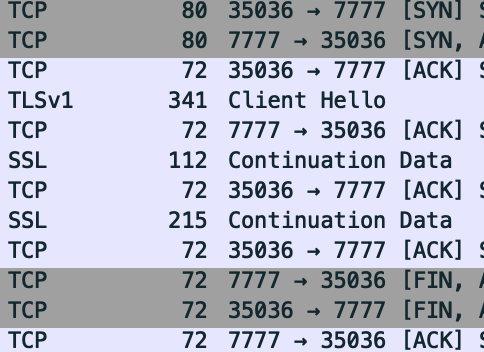-
Notifications
You must be signed in to change notification settings - Fork 8.5k
Description
NGINX Ingress controller version (exec into the pod and run nginx-ingress-controller --version.):
Release: v0.34.1 Build: v20200715-ingress-nginx-2.11.0-8-gda5fa45e2 Repository: https://github.com/kubernetes/ingress-nginx nginx version: nginx/1.19.1
Kubernetes version:
v1.21.3-gke.2001
Environment:
- Cloud provider or hardware configuration:
GKE - OS (e.g. from /etc/os-release):
NAME="Alpine Linux" ID=alpine VERSION_ID=3.11.6 PRETTY_NAME="Alpine Linux v3.11" HOME_URL="https://alpinelinux.org/" BUG_REPORT_URL="https://bugs.alpinelinux.org/" - Kernel:
Linux ingress-nginx-internal-controller-57d96fbbcd-nzspj 5.4.120+ #1 SMP Tue Jun 22 14:53:20 PDT 2021 x86_64 Linux
What happened:
I am exposing a non-standard TCP port (not 443) on an GRPC Ingress via this guide: https://kubernetes.github.io/ingress-nginx/user-guide/exposing-tcp-udp-services/
I have confirmed the Ingress is listening on the port, but I also see the Controller is doing a TCP/TLS health check to the backend service, which we dont want. We just want an unencrypted health check.
I only see this message in the log regarding the TCP healthcheck:
[10.130.0.17] [10/Sep/2021:17:44:23 +0000] TCP 200 183 269 0.001
I did a packet capture with tcpdump/wireshark and verified there is a TLS handshake.
Why is the health check using TLS and not unencrypted TCP? Is this configurable anywhere? The backend isnt even using TLS.
Here are the server error logs indicating that it wasn't expecting TLS TCP traffic:
INFO: Transport failed
io.grpc.netty.shaded.io.netty.handler.codec.http2.Http2Exception: HTTP/2 client preface string missing or corrupt. Hex dump for received bytes: 1603010108010001040303c16e175ac9b1af596e1a0f2d43
at io.grpc.netty.shaded.io.netty.handler.codec.http2.Http2Exception.connectionError(Http2Exception.java:103)
at io.grpc.netty.shaded.io.netty.handler.codec.http2.Http2ConnectionHandler$PrefaceDecoder.readClientPrefaceString(Http2ConnectionHandler.java:306)
at io.grpc.netty.shaded.io.netty.handler.codec.http2.Http2ConnectionHandler$PrefaceDecoder.decode(Http2ConnectionHandler.java:239)
at io.grpc.netty.shaded.io.netty.handler.codec.http2.Http2ConnectionHandler.decode(Http2ConnectionHandler.java:438)
at io.grpc.netty.shaded.io.netty.handler.codec.ByteToMessageDecoder.decodeRemovalReentryProtection(ByteToMessageDecoder.java:501)
at io.grpc.netty.shaded.io.netty.handler.codec.ByteToMessageDecoder.callDecode(ByteToMessageDecoder.java:440)
at io.grpc.netty.shaded.io.netty.handler.codec.ByteToMessageDecoder.channelRead(ByteToMessageDecoder.java:276)
at io.grpc.netty.shaded.io.netty.channel.AbstractChannelHandlerContext.invokeChannelRead(AbstractChannelHandlerContext.java:379)
at io.grpc.netty.shaded.io.netty.channel.AbstractChannelHandlerContext.invokeChannelRead(AbstractChannelHandlerContext.java:365)
at io.grpc.netty.shaded.io.netty.channel.AbstractChannelHandlerContext.fireChannelRead(AbstractChannelHandlerContext.java:357)
at io.grpc.netty.shaded.io.netty.channel.DefaultChannelPipeline$HeadContext.channelRead(DefaultChannelPipeline.java:1410)
at io.grpc.netty.shaded.io.netty.channel.AbstractChannelHandlerContext.invokeChannelRead(AbstractChannelHandlerContext.java:379)
at io.grpc.netty.shaded.io.netty.channel.AbstractChannelHandlerContext.invokeChannelRead(AbstractChannelHandlerContext.java:365)
at io.grpc.netty.shaded.io.netty.channel.DefaultChannelPipeline.fireChannelRead(DefaultChannelPipeline.java:919)
at io.grpc.netty.shaded.io.netty.channel.epoll.AbstractEpollStreamChannel$EpollStreamUnsafe.epollInReady(AbstractEpollStreamChannel.java:792)
at io.grpc.netty.shaded.io.netty.channel.epoll.EpollEventLoop.processReady(EpollEventLoop.java:475)
at io.grpc.netty.shaded.io.netty.channel.epoll.EpollEventLoop.run(EpollEventLoop.java:378)
at io.grpc.netty.shaded.io.netty.util.concurrent.SingleThreadEventExecutor$4.run(SingleThreadEventExecutor.java:989)
at io.grpc.netty.shaded.io.netty.util.internal.ThreadExecutorMap$2.run(ThreadExecutorMap.java:74)
at io.grpc.netty.shaded.io.netty.util.concurrent.FastThreadLocalRunnable.run(FastThreadLocalRunnable.java:30)
at java.lang.Thread.run(Thread.java:748)
Sep 10, 2021 6:07:37 PM io.grpc.netty.shaded.io.grpc.netty.NettyServerTransport notifyTerminated
What you expected to happen:
Since no resources (Service, ConfigMap, Ingress, etc) are configured to use TCP/TLS for the Service backend health check, it should just use an unencrypted TCP health check.
How to reproduce it:
- Follow this guide to expose a TCP port on an Ingress: https://kubernetes.github.io/ingress-nginx/user-guide/exposing-tcp-udp-services/
- Do a packet capture and check for a TLS handshake (SYN, ACK, SYN-ACK, FIN)
/kind bug
